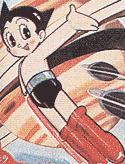|
"It was the Japanese ... who published the first cheap, mass-produced, regularly scheduled comic books in the 1920's.
Printed (sometimes in color) on pulp paper and distributed on a monthly basis, they actually predated the American comic
book by a good 10 years." <The World Encyclopedia of Comics> ed. Maurice Horn
Comics, to most Westerners, is "Superman" or "Spiderman." Fourteen year old boys and college students
read comics. But in Japan, nearly everyone reads manga. Why the difference?

Manga and anime are steadily trickling into the Western world for the same reasons they are
popular in Japan: adult themes, variety, and complexity. In Japan, manga fills the niche of not only comics, but also magazines
(from sports and poker to childcare and cooking), study guides, movies, and novels. Manga characters are not often superheroes,
and therefore plots avoid the simplicity that superpowers tend to give to a situation. Furthermore, the duality of good and
evil ("Batman and Joker") that springs from the God and Devil of Christianity is not inevitable for comics based in a Shinto/Buddhist
culture.

Visually, many manga and anime styles originate in the work of Osamu Tezuka, the "god of manga," also known as the
"Walt Disney of Japan." One of the first anime to make it to the U.S. was Tezuka's "Astro Boy." His
admiration of Disney's work likely contributed to his characters' big dewy eyes and big poufy hairstyles. Tezuka also set
off shojo manga (girls' comics) trends toward bishonen (pretty-boy) heroes, with his crossdresser heroine of "Princess
Knight." Male characters began to be drawn big-eyed and effeminate to demonstrate their empathetic natures. Outsiders
or unsympathetic characters were drawn small-eyed and more realistically. As for content, Tezuka broadened manga/anime's
scope to include themes such as alienation, prejudice, and death, even in those titles aimed at children.
text on this page by Susan Sieber
|